Keep It Simple Stupid
For the moment let’s forget fancy climate models. Forget what might or might not have been causes for the world to get warm or cold in the past. Just ask two simple questions:
1) What do we need to know to decide if global warming is happening now or not?
2) What do we need to know to decide if global warming is caused by CO2 and other greenhouse gases or not?
Some Simple Answers: Global Warming
If global warming is happening, the average annual temperature of the air over the land and the ocean should be rising.
Yes, average annual temperature is rising.
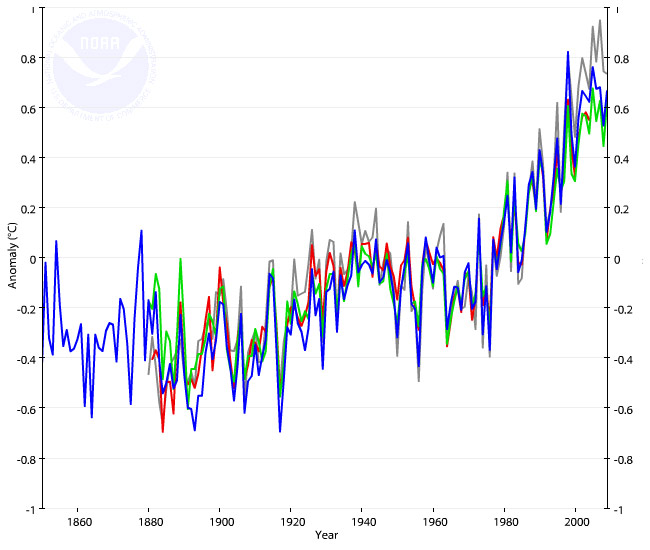 Data and graph from Climate Indicators, National Oceanic and Atmospheric Administration
Data and graph from Climate Indicators, National Oceanic and Atmospheric Administration
National Climatic Data Center. CRUTEM3 (blue) NASA/GISS (green) Lugina et al. (red) NOAA/NCDC (grey)
If global warming is happening, the average annual sea surface temperature should be rising.
Yes, average annual sea surface temperature is rising.
 Data and graph from Climate Indicators, National Oceanic and Atmospheric Administration
Data and graph from Climate Indicators, National Oceanic and Atmospheric Administration
National Climatic Data Center. COBE (green) ERSST3 (grey) HadSST2 (orange) ICOADS (red) Kaplan (blue) SOC (yellow)
If global warming is happening, the average annual ocean heat content in the upper 700m should be rising.
Yes, average annual ocean heat content is rising.
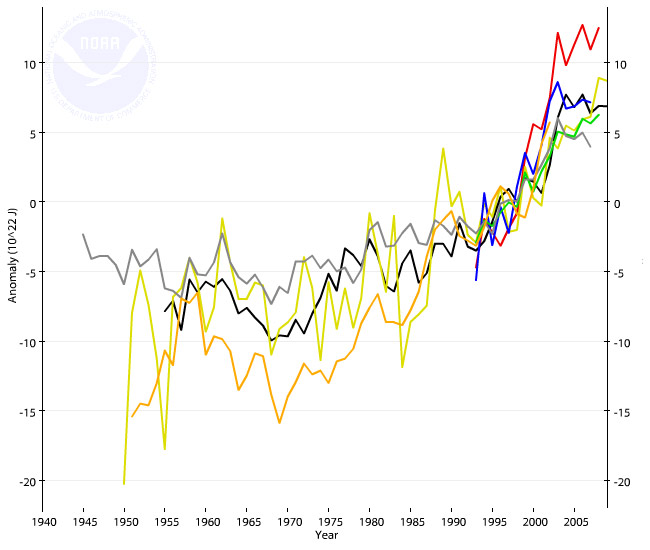 Data and graph from Climate Indicators, National Oceanic and Atmospheric Administration National Climatic Data Center. Domingues et al. (orange) Ishii and Kimoto (grey) Willis et al. (green) Lyman and Johnson (blue) Palmer et al. (yellow) Levitus et al. (black) Gouretski and Reseghetti (red)
Data and graph from Climate Indicators, National Oceanic and Atmospheric Administration National Climatic Data Center. Domingues et al. (orange) Ishii and Kimoto (grey) Willis et al. (green) Lyman and Johnson (blue) Palmer et al. (yellow) Levitus et al. (black) Gouretski and Reseghetti (red)
If global warming is happening, the average extent of sea ice in September (the usual minimum extension) should be declining.
Yes, average extent of sea ice in September is declining.
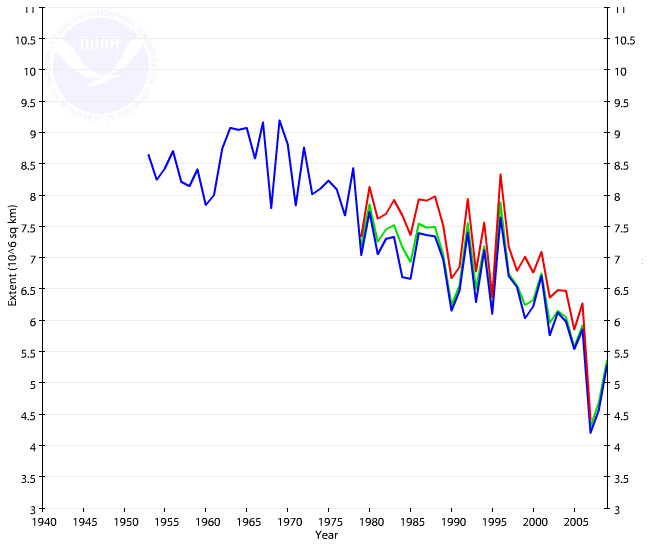 Data and graph from Climate Indicators, National Oceanic and Atmospheric Administration National Climatic Data Center. NASA bootstrap algorithm (red) HadISST (blue) Fetterer et al. (green)
Data and graph from Climate Indicators, National Oceanic and Atmospheric Administration National Climatic Data Center. NASA bootstrap algorithm (red) HadISST (blue) Fetterer et al. (green)
If global warming is happening, the average extent of northern hemisphere snow cover should be declining.
Yes, average extent of northern hemisphere snow cover is declining.
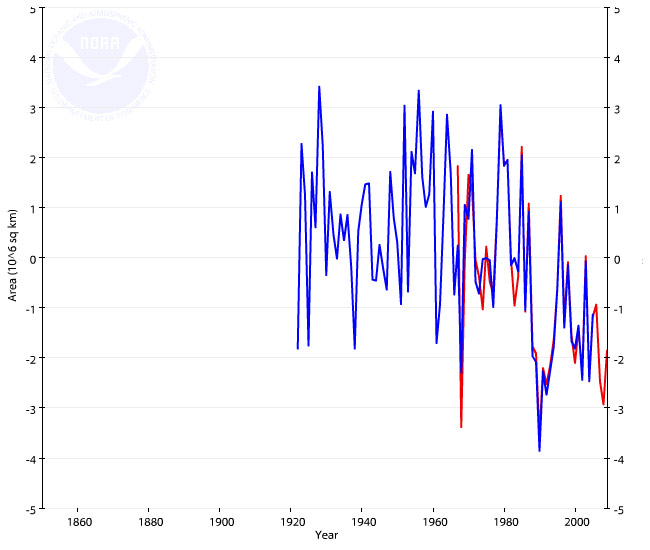 Data and graph from Climate Indicators, National Oceanic and Atmospheric Administration National Climatic Data Center. IPCC AR4 SPM (blue) Robinson and Frei (red)
Data and graph from Climate Indicators, National Oceanic and Atmospheric Administration National Climatic Data Center. IPCC AR4 SPM (blue) Robinson and Frei (red)
If global warming is happening, the glacier mass balance should be declining.
Yes, glacier mass balance is declining.
 Data and graph from Climate Indicators, National Oceanic and Atmospheric Administration National Climatic Data Center. Cogley (simple average) (green) Cogley (interpolated) (grey) WGMS (all glaciers) (blue) WGMS (reference set) (red)
Data and graph from Climate Indicators, National Oceanic and Atmospheric Administration National Climatic Data Center. Cogley (simple average) (green) Cogley (interpolated) (grey) WGMS (all glaciers) (blue) WGMS (reference set) (red)
If global warming is happening, the sea levels should be rising.
Yes, the sea levels are rising.
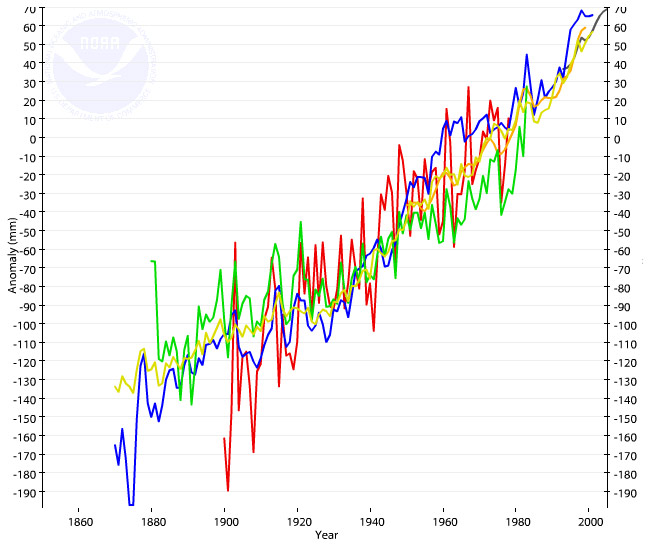 Data and graph from Climate Indicators, National Oceanic and Atmospheric Administration National Climatic Data Center. Church and White (yellow) Gornitz and Lebedeff (green) Holgate and Woodworth (orange) Jevrejeva et al. (blue) Leuliette et al. (black) Trupin and Wahr (red)
Data and graph from Climate Indicators, National Oceanic and Atmospheric Administration National Climatic Data Center. Church and White (yellow) Gornitz and Lebedeff (green) Holgate and Woodworth (orange) Jevrejeva et al. (blue) Leuliette et al. (black) Trupin and Wahr (red)
If global warming is happening, the temperature of the troposphere should be rising.
Yes, the temperature of the troposphere is rising.
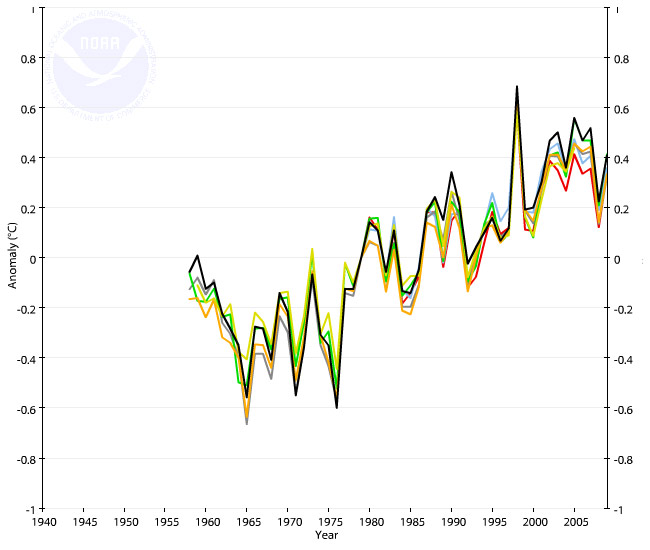 Data and graph from Climate Indicators, National Oceanic and Atmospheric Administration National Climatic Data Center. HadAT2 (black) IUK (grey) RAOBCORE (orange) RATPAC (green) RICH (grey) RSS (pale blue) UAH (red)
Data and graph from Climate Indicators, National Oceanic and Atmospheric Administration National Climatic Data Center. HadAT2 (black) IUK (grey) RAOBCORE (orange) RATPAC (green) RICH (grey) RSS (pale blue) UAH (red)
One More Simple Answer: CO2 and Global Warming
For more than 150 years CO2 has been known to selectively reflect radiant energy. This effect is known as the greenhouse gas effect. Radiant energy from the sun is the basic source of energy to heat our world. If the world is getting warmer from causes other than greenhouse gases, both the lower atmosphere (the troposphere) and the upper level of the atmosphere (the stratosphere) will be getting warmer. If excess CO2 is reflecting some of the heat back to space while selectively reflecting the black-body radiation from the earth back toward the earth, then the stratosphere should be getting colder while the troposphere is getting warmer. So this is a crucial test to determine if the rising temperature of the earth is an effect of excess CO2 being added to the world’s atmosphere.
If global warming is caused by CO2 the temperature of the stratosphere should be declining. If global warming is due to other causes the temperature of the stratosphere should rising.
Look at that! The temperature of the stratosphere is falling.
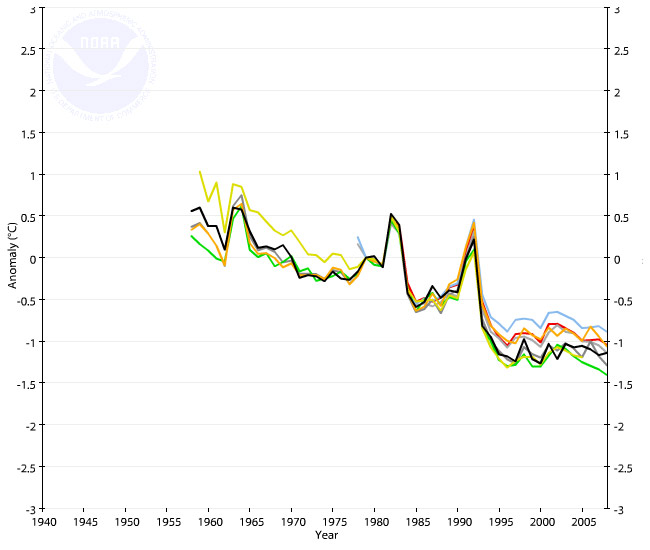 Data and graph from Climate Indicators, National Oceanic and Atmospheric Administration National Climatic Data Center. HadAT2 (black) IUK (yellow) RAOBCORE (orange) RATPAC (green) RICH (grey) RSS (pale blue) STAR (pale grey) UAH (red)
Data and graph from Climate Indicators, National Oceanic and Atmospheric Administration National Climatic Data Center. HadAT2 (black) IUK (yellow) RAOBCORE (orange) RATPAC (green) RICH (grey) RSS (pale blue) STAR (pale grey) UAH (red)
Conclusions
The first conclusion from KISS information is that global warming is happening now. The second conclusion from KISS information is that CO2 is part of the cause of global warming.
How Much Hotter? How Much Melting? How High Will the Sea level Rise?
We have known for over a century that CO2 by itself (if no other factors are involved) can raise the temperature by 1.1C every time the concentration of CO2 is doubled.
Since the 1880s, the CO2 concentration in the atmosphere has come up about 45% from burning fossil fuels. Water vapour is a very strong greenhouse gas but remains more-or-less constant in the atmosphere, increasing or decreasing on average as temperature rises or falls. Aerosols and particles in the air prevent sunlight energy from reaching the earth causing the temperatures to fall. Dust from volcanoes causes the temperature to fall. Rising ocean heat increases water vapour and thus the temperature. Variations in solar radiation (heat from the sun), such as the Milankovitch and Maunder cycles cause the temperatures to vary up and down. Methane released from melting Arctic soils is a greenhouse gas and raises the temperature. So there are lots of factors.
By adding and subtracting all these positive and negative effects, we can come up with a number to use as the amount of temperature that will result from doubling CO2. The final number is called climate sensitivity. It adds up the effect of CO2 and the other positive effects that cause the temperature to rise as CO2 is added, and subtracts the negative effects that cause the temperature to fall. A recent look by the author of the blog Mabinogogiblog (also known as @DocRichards on Twitter) at ten estimates of climate sensitivity based only on direct measurements and observations (no models) came up with an average of between 1.8C and 3.9C.
What does this mean? It means that for each doubling of the amount of CO2 in the atmosphere, no matter where you start the doubling, the average increase of global temperature will be between 1.8C and 3.9C, or about 3C as an average estimate. The change in temperature is not instantaneous, it takes time (decades) to reach the new level and stabilize at the new temperature.
The recent change of CO2 concentration in the atmosphere began in the 1950s. Since then the concentration has risen about 45%, so it still has not doubled yet. So if we do a really, really crude estimate, the CO2 is up about 45% of double so the global temperature should rise somewhere between 0.8C and 1.7C with this amount of CO2 given enough time to settle out. The actual observed rise in global temperature (which we can read from our graph) is about 0.7C to 0.9C. So the observed numbers and the numbers we predicted from our KISS information are definitely in the same ballpark.
Let’s just see what happens if adding CO2 to the atmosphere continues until the CO2 concentration doubles. Our little formula would predict about 2C to 4C above today’s temperature. Call it down the middle at 3C.
How much will the sea level rise? You can make this estimate for yourself from the chart. Just visually continue the accelerating rising trend. It could be between about 25cm and one meter by the time CO2 doubles.
How much ice will melt? The Arctic will be ice free in the summer.
What Would It Be Like If People Were Not Here?
If people didn’t exist, what would the temperature be like today on earth? If you look at this chart of the past 500,000 years, you can see both ice ages and warm periods. You have to read this chart from the far end (past) to the beginning of the chart (the present). The ice ages are longer than the warm periods and it looks like the warm periods are getting shorter and shorter. ON this chart it looks like the earth should be heading for another ice age pretty soon or even right about now.
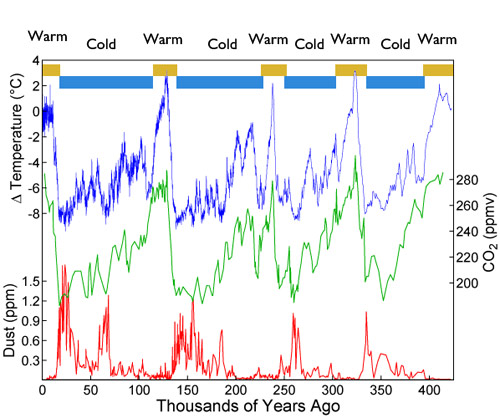 This original graph is courtesy of Vostok-ice-core-petit.png: NOAA, and is a derivative work: Autopilot, to which I added the warm cold text and graphic. The original data sets are available from: Noaa set #1, Noaa set #2, and Noaa set #3
This original graph is courtesy of Vostok-ice-core-petit.png: NOAA, and is a derivative work: Autopilot, to which I added the warm cold text and graphic. The original data sets are available from: Noaa set #1, Noaa set #2, and Noaa set #3
Over the last 20,000 years, the earth has warmed up from the last ice age and in the past 8,000 years the temperature looks to be on a constant trend line showing a slight cooling from about 4,000 years ago, but with some pretty big variations up and down.
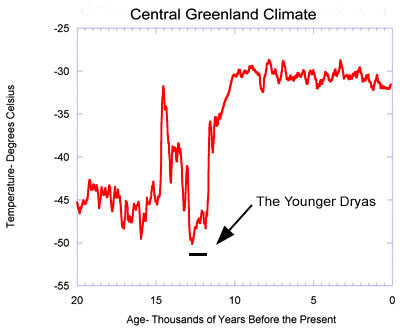
Central Greenland temperature over the past 20,000 years from analysis of oxygen isotope ratios in Greenland ice cores. From NOAA The Younger Dryas cold interval as viewed from central Greenland.
Examining the past 8,000 years, there is an obvious trend to cooler weather. So it looks like the trend was in fact headed for an ice age. That in itself is a bit of a scary thought. Although the time to reach a real ice age would probably have been a couple of thousand years, it is nonetheless, not a very comforting thought that our grandchildren and their descendants could be heading for the deep freeze.
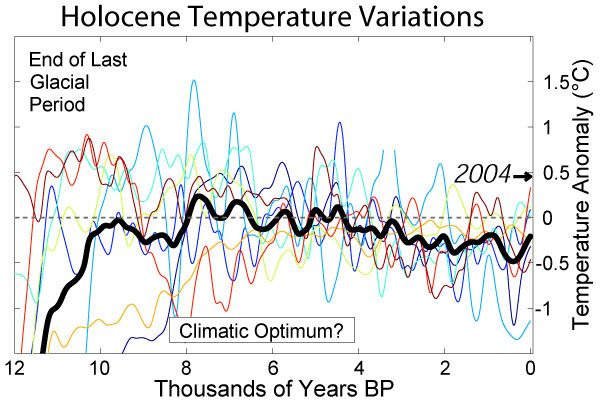 The following data sources were used in constructing the main plot: (dark blue) Zhao, Beveridge, Shackleton, Sarnthein, and Eglinton. Paleoceanography 10 (3): 661-675. (blue) Petit, Jouzel, Raynaud, Barkov, Barnola, Basile, Bender, Chappellaz, Davis, Delaygue, Delmotte, Kotlyakov, Legrand, Lipenkov, Lorius, Pépin, Ritz, Saltzman, Stievenard. Nature 399: 429-436. (light blue) Alley. Quaternary Science Reviews. doi:10.1016/S0277-3791(99)00062-1 (green) Thompson, Mosley-Thompson, Davis, Henderson, Brecher, Zagorodnov, Mashiotta, Lin,Mikhalenko, Hardy, and Beer. Science 298 (5593): 589-593. (yellow) Lea, Pak, Peterson, and Hughen (2003). Science 301 (5638): 1361-1364. (orange) Davis, Brewer, Stevenson, Guiot (2003). Quaternary Science Reviews 22: 1701-1716. (red) EPICA community members (2004). Nature 429 (6992): 623-628. (dark red) Stott, Cannariato, Thunell, Haug, Koutavas, and Lund (2004). Nature 431: 56-59. Plot by Robert A. Rohde
The following data sources were used in constructing the main plot: (dark blue) Zhao, Beveridge, Shackleton, Sarnthein, and Eglinton. Paleoceanography 10 (3): 661-675. (blue) Petit, Jouzel, Raynaud, Barkov, Barnola, Basile, Bender, Chappellaz, Davis, Delaygue, Delmotte, Kotlyakov, Legrand, Lipenkov, Lorius, Pépin, Ritz, Saltzman, Stievenard. Nature 399: 429-436. (light blue) Alley. Quaternary Science Reviews. doi:10.1016/S0277-3791(99)00062-1 (green) Thompson, Mosley-Thompson, Davis, Henderson, Brecher, Zagorodnov, Mashiotta, Lin,Mikhalenko, Hardy, and Beer. Science 298 (5593): 589-593. (yellow) Lea, Pak, Peterson, and Hughen (2003). Science 301 (5638): 1361-1364. (orange) Davis, Brewer, Stevenson, Guiot (2003). Quaternary Science Reviews 22: 1701-1716. (red) EPICA community members (2004). Nature 429 (6992): 623-628. (dark red) Stott, Cannariato, Thunell, Haug, Koutavas, and Lund (2004). Nature 431: 56-59. Plot by Robert A. Rohde
[EDIT: MARCH 8 2013] New information has just been published. “What’s different is the rate of change,” said Shaun Marcott, a paleoclimatologist at Oregon State and lead author of the paper. “What we’ve seen over the past 150 years is much greater than anything we saw in the past 11,000 years.”
The temperature continues to rise and on average is now as warm or warmer than the Medieval Warm period and warmer than in the last 11,000 years. Furthermore the onset is very recent and rate of increase shows no signs of slowing down despite any small efforts by the world’s leaders. [end EDIT]
If people weren’t here and enjoying the fruits of the Industrial Age, the earth would have been stable for a while, but gradually cooling off and headed for an ice age. And while the KISS approach is anything but perfect, for those who just want simple facts, it looks pretty clear that global warming is a real phenomenon and that this time at least, it is caused by people burning fossil fuels.
So What Does this Mean for Me?
First of all, this is not really about you or me. We might suffer a little, but neither of us will really suffer very much from this because we just won’t live long enough. It will take about 70 to 100 years to reach the first complete doubling of CO2. So this discussion and the results of your actions is about your children, your grandchildren, and their descendants.
If the KISS approach is valid, and if the temperature rises continue as they have been, this will cause the sea level to continue to rise. Many millions of people will need to move either from islands, from parts of the the tropics, or from beach-front areas to higher ground away from the ocean. Millions of farms, big and small will need to move from areas that have become too dry, or too wet, or too hot. Hundreds of trillions of dollars or more in infrastructure, expensive beach front properties, road systems and so on will be lost. Hurricane Sandy was not an especially strong hurricane, but because of the slightly higher sea levels, the homes, offices, subways and many other parts of the infrastructure which had been built for a lower sea level, got severely damaged when the surge, high tides, and strong winds conspired to overwhelm the defenses. Much stronger hurricanes have hit in the past. Likely the damage will be even more severe when that happens again with still higher sea levels. The ability of agriculture to keep up with the changes and also to feed the extra 2 billion people will be severely compromised. The storehouse of tropical biodiversity will be severely reduced. Extreme events will become increasingly common. Insect disease and pest vectors will be able to migrate to areas that are now too cold for them and there are few natural defenses and still fewer artificial defenses against them.
Managing Global Warming
It is definitely a mistake to waste vast amounts of money on insufficiently planned efforts to manage the climate of the world, especially such scary propositions as attempting to cool the earth by spreading particles in the atmosphere. Maybe there is a clear answer looming here. Can we manage the temperature of the earth by managing the amount of CO2 in the atmosphere, holding the temperature to a nice comfortable range somewhere just about where it was for the last 6000 years? These temperatures allowed humankind to flower, agriculture to develop, and the Industrial Revolution followed by the digital age to happen. Imagine how we might continue to improve our situation if we manage our environment using the simple tool that is clearly available to us? If so, how would we do that?
Consider that if we were not burning fossil fuels, we and our descendants would be heading for an ice age. But because we are indeed burning too much fossil fuel we are headed for a hot house age, and by all scientific indicators, a bad one. Neither of these options is great news! But to misunderstand and not to recognize that CO2 is a useful and absolutely essential part of the climate is to commit an equally enormous error. CO2 is not an enemy, it is a necessary and very beneficial gas in many ways essential to our existence on this planet. Too much or too little CO2 however, is a major problem. So the answer is sensible management. Management gets increasingly difficult as time goes by, so the most important part of the management is to begin now.
CO2 is also not the only greenhouse gas that is a problem. Methane (CH4) and chlorofluorocarbons (CFCs) are even more potent greenhouse gases that are being pumped in excess into the atmosphere. CFCs have the added scary action of destroying ozone (O3). Ozone protects us from ultraviolet rays. By releasing huge amounts of CFCs into the atmosphere, holes in the ozone layer appeared. While a treaty amongst nations has curtailed the use of CFCs, not all nations abide by the treaty and amazing amounts of illegal CFCs are still being released into the atmosphere. Methane is produced from many urban, agricultural, and industrial sources.
“Harvest the low-hanging fruit first” is a term used to describe the economic benefits of going for the easy stuff first but recognizing that some of the profit from those easy efforts can be turned into research projects designed to find ways to harvest the more difficult sources. In this triumvirate of greenhouse gases, the easiest to deal with is CFCs. There are great alternatives, and CFCs are illegal. Industrial marketing into areas where illegal CFCs, combined with increased policing in part funded by the industry wanting to sell CFC alternatives would be a great place to start. The technology for harvesting methane and using it for heating or electricity is already very well-developed and used routinely in municipalities and on farms. This could be expanded by extending large tax benefits to investors in both methane and CFC recovery and substitution industries.
The rationale for going after these easy gases is to draw down the effects of excess carbon as quickly and inexpensively, indeed hopefully lucratively, as possible. Meanwhile offering tax incentives to alternative forms of energy and investing research funding in such things as solar, wind, fuel cells, high efficiency batteries and other long-term ideas would not be costly. The returns are already beginning to come in where governments have made commitments to using these alternative energy sources.
Ultimately though, the big deal is a combination of fossil fuels and carbon sinks. While there are sufficient reserves and new deposits of fossil fuels to last perhaps another hundred years of relatively inexpensive energy, they will definitely become increasingly expensive and ultimately will run out. Then the ocean and forests will gradually absorb the extra CO2 and the world will move along its “normal” several-thousand year path toward an ice age.
Carbon Banking
What will our ancestors need if they are to “manage” the climate? Some ready sources of CO2 to counteract the waning power of sun would be a help for sure. And excess CO2 is just what we don’t need right now. Capturing CO2 from smoke stacks, chimneys, vents, tailpipes, and other sources of CO2 is not rocket science. There are even some ideas on capturing CO2 from the atmosphere. But the most efficient process right now is to capture it at the sources where it is hundreds of times more concentrated than in the atmosphere. If we were also to institute a “banking system for carbon” so that our descendants have ready access to huge reserves of carbon that can be used to judiciously manage the climate, I have no doubt they would look back and say thank you. Using it all up right now while creating a problem for ourselves seems inherently stupid. At the same time, wild-eyed claims that death and destruction is right around the corner are also stupid.
CO2 lasts a long time in the atmosphere before it is absorbed naturally, so if the concentration gets too high too fast, the natural carbon “sinks” (such as the ocean and forests) will end up even more overloaded than they are right now. Prudent behaviour to limit that concentration and to do so by both financially rewarding and economically reasonable means, is sensible. Combining that with a means of providing a source through a massive banking or storage system for the future generations who will need it, is also prudent, and not terribly expensive.
One person (clearly intelligent and literate) on Twitter told me that he does not consider himself accountable to anybody in the future because he won’t be there to pay the fine or to go to jail. Thus, he will concern himself only with present-day issues and costs.
Many others have expressed the opinion vehemently that the science is not settled and nobody has “proven” that all these dire predictions are actually going to come true. As we have seen using only actual facts in a KISS approach, it’s pretty darn obvious global warming is happening and that CO2 is the cause. Predicting exactly how fast it will occur in the future and exactly what the consequences will be is not possible, but it does not take much imagination to make some pretty simple guesses that it is not a good idea to let this go on very much longer.
For those who share the notion that we don’t owe anything to our descendants, and for those who aren’t going to be convinced that global warming is caused by people, the choice is simple – do nothing about managing the situation in the future, just adapt to the situation as it changes around you. At least for a while, this will definitely be the cheapest approach.
For the rest of us, however, we might choose to think about the distant past on earth, the likelihood of an ice age if we hadn’t been here, and the potential to lose it all by throwing away the obvious tools for our children, grandchildren, and their descendants to manage the climate of the earth. Tossing carbon into the atmosphere and using up the fuel sources in a few short hundred years is not a smart move. It is also unfair to future generations. Developing sensible, economically feasible and financially rewarding ways of managing the climate, while salting away reserves for our kids and their kids is just plain common sense.

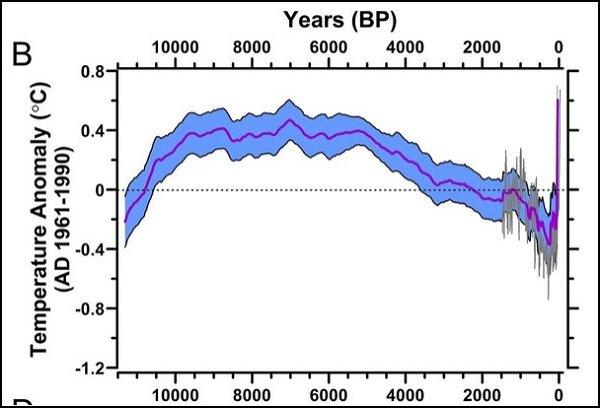
I realize I’ve never got this far before! Wow. Impressive!!!!!!!!!!!!